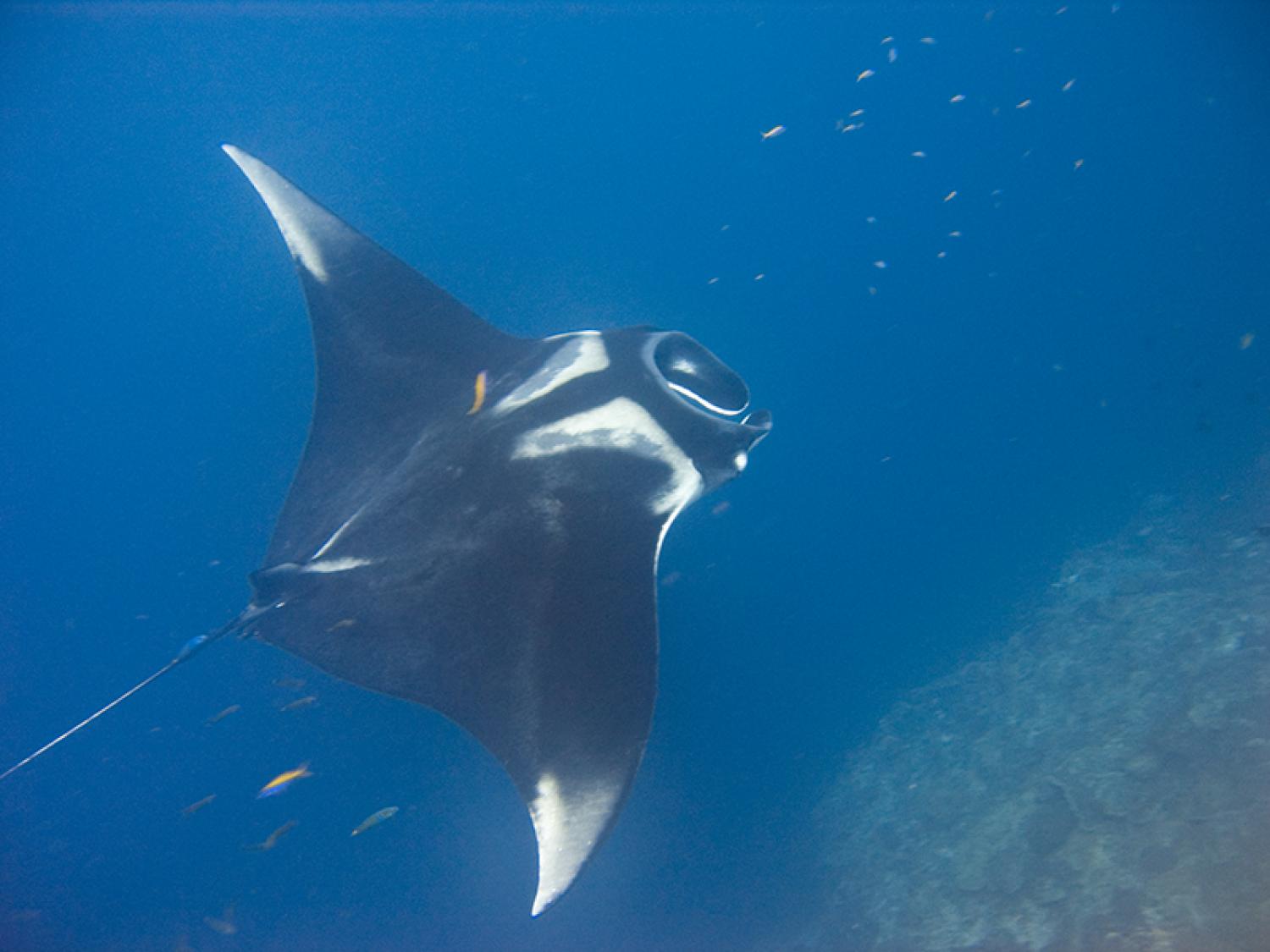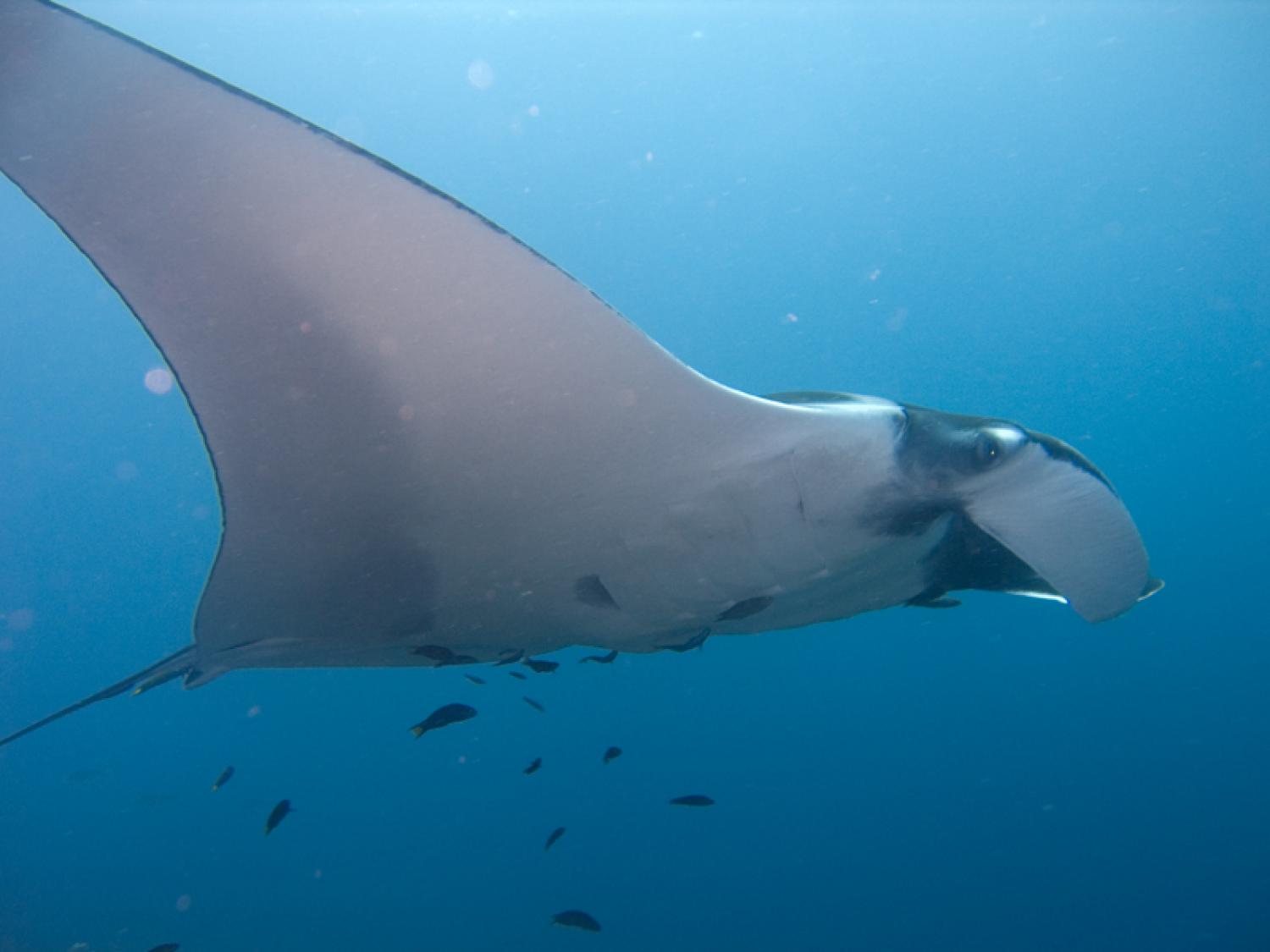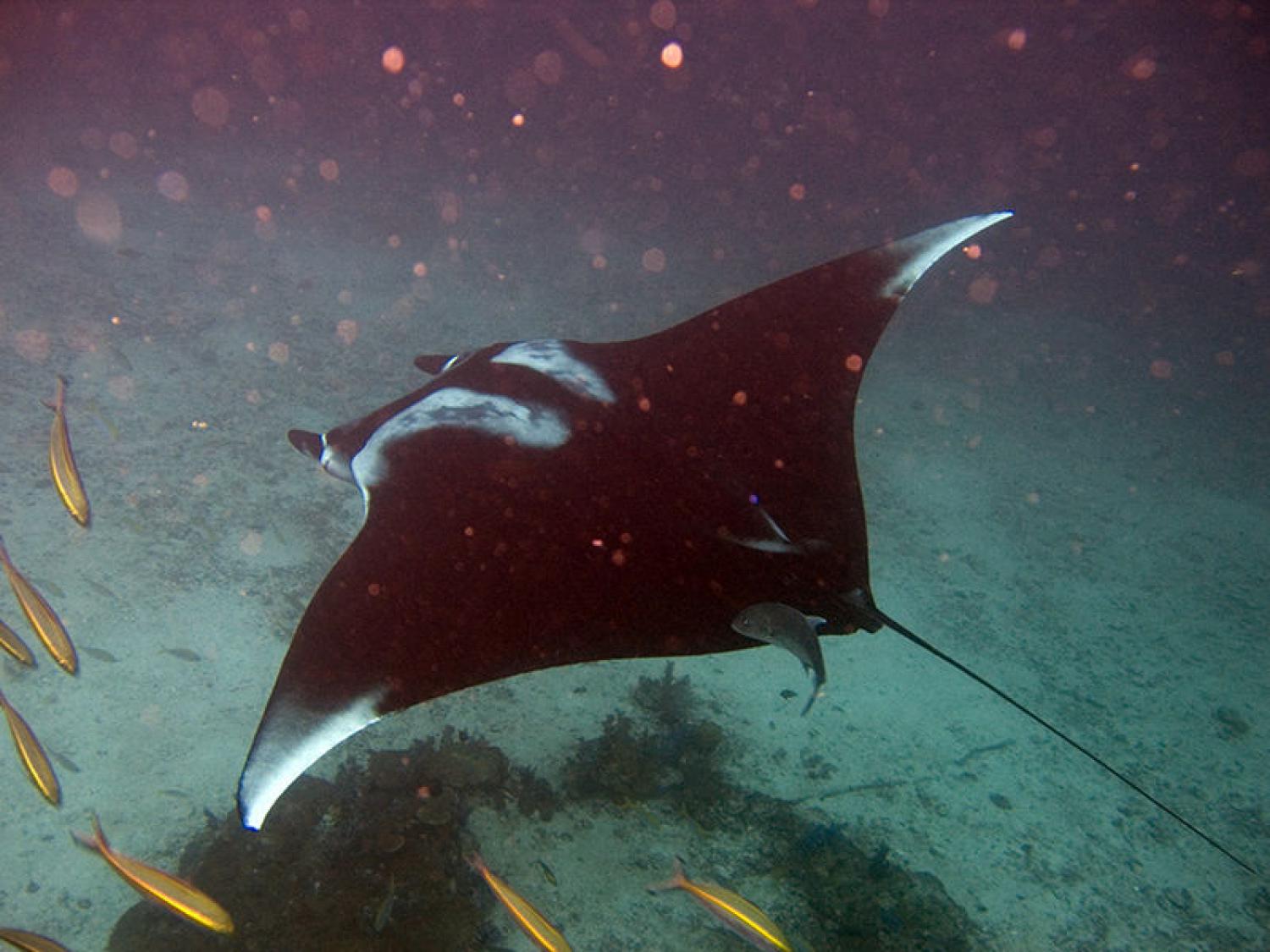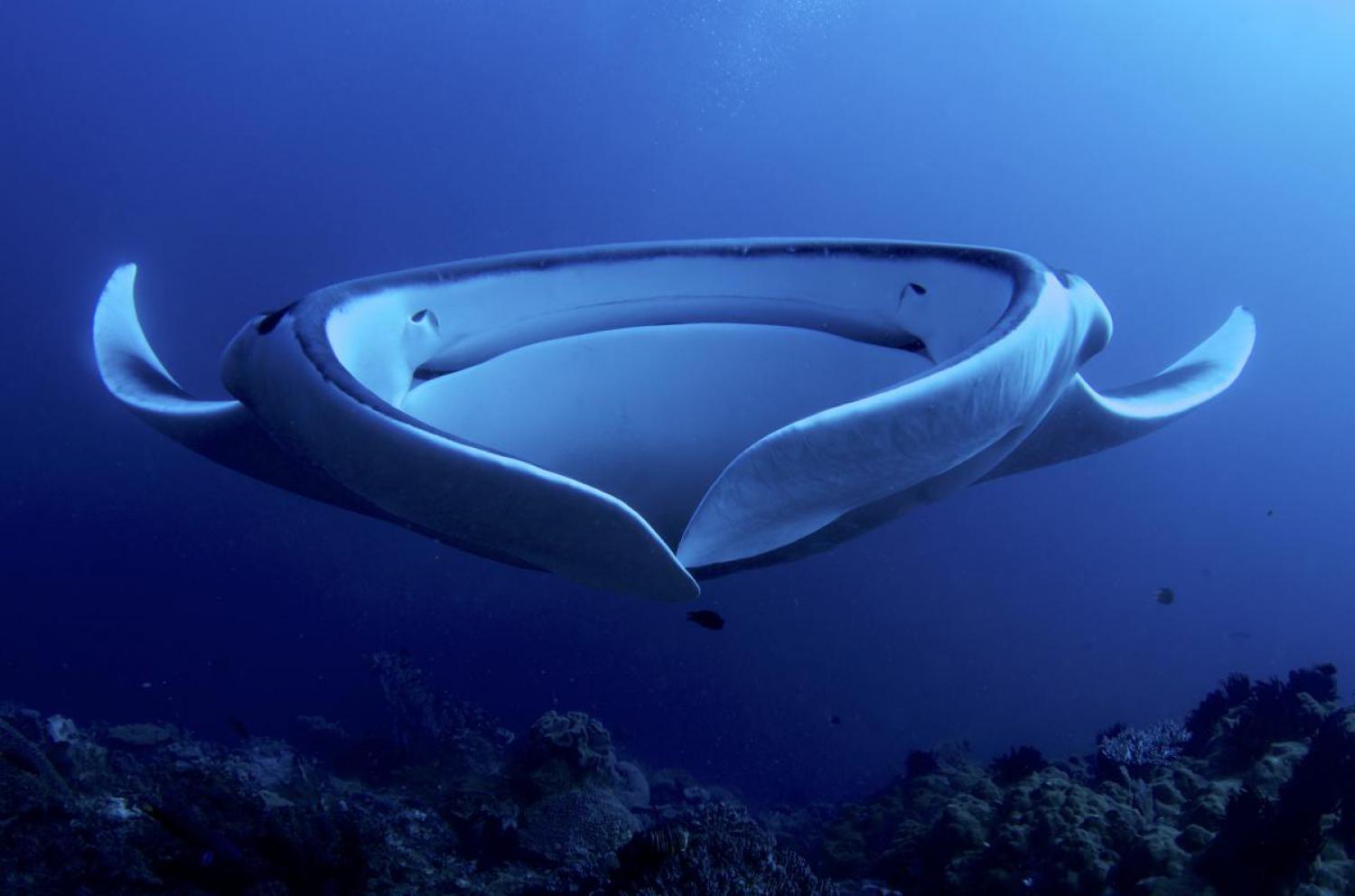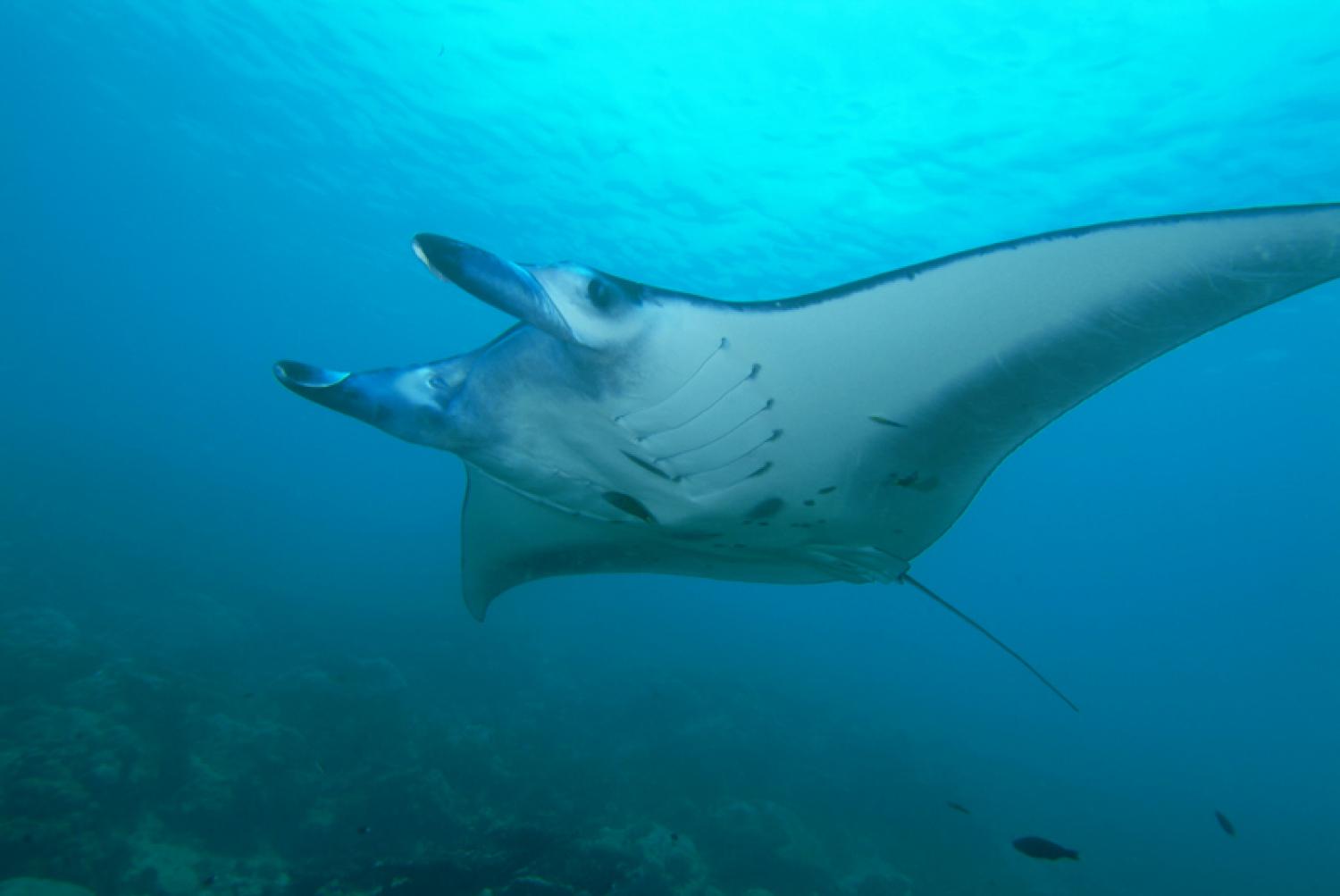Species of Thailand
Manta ray
Manta birostris
Edward Nathaniel Bancroft, 1829
Manta rays are large rays belonging to the genus Manta. The larger species, M. birostris, reaches 7 m in width, while the smaller, M. alfredi, reaches 5.5 m ftin. Both have triangular pectoral fins, horn-shaped cephalic fins and large, forward-facing mouths. They are classified among the Myliobatiformes (stingrays and relatives) and are placed in the family Myliobatidae (eagle rays).
Mantas are found in warm temperate, subtropical and tropical waters. Both species are pelagic; M. birostris migrates across open oceans, singly or in groups, while M. alfredi tends to be resident and coastal. They are filter feeders and eat large quantities of zooplankton, which they gather with their open mouths as they swim. However, research suggests that the majority of their diet (73%) actually comes from mesopelagic sources; that is, they are actually deep sea predators, feeding on fish and other organisms that inhabit areas of the sea from 650-3330 order=flip -2 below the surface.
Gestation lasts over a year and mantas give birth to live pups. Mantas may visit cleaning stations for the removal of parasites. Like whales, they breach for unknown reasons.
Both species are listed as vulnerable by the International Union for Conservation of Nature. Anthropogenic threats include pollution, entanglement in fishing nets, and direct harvesting for their gill rakers for use in Chinese medicine. Their slow reproductive rate exacerbates these threats. They are protected in international waters by the Convention on Migratory Species of Wild Animals, but are more vulnerable closer to shore. Areas where mantas congregate are popular with tourists. Only a few public aquariums are large enough to house them.
Taxonomy and etymology
The name "manta" is Portuguese and Spanish for mantle (cloak or blanket), a type of blanket-shaped trap traditionally used to catch rays. Mantas are known as "devilfish" because of their horn-shaped cephalic fins, which are imagined to give them an "evil" appearance.
Manta rays are members of the order Myliobatiformes which consists of stingrays and their relatives. The genus Manta is part of the eagle ray family Myliobatidae, where it is grouped in the subfamily Mobulinae along with the Mobula devil rays. In 2017, an analysis of DNA, and to a lesser degree, morphology, found that Mobula was paraphyletic with respect to the manta rays, and they recommended treating Manta as a junior synonym of Mobula.
Mantas evolved from bottom-dwelling stingrays, eventually developing more wing-like pectoral fins. M. birostris still has a vestigial remnant of a sting barb in the form of a caudal spine. The mouths of most rays lie on the underside of the head, while in mantas, they are right at the front. Manta rays and devil rays are the only ray species that have evolved into filter feeders.
Species
The scientific naming of mantas has had a convoluted history, during which several names were used for both the genus (Ceratoptera, Brachioptilon Daemomanta, and Diabolicthys) and species (such as vampyrus, americana, johnii, and hamiltoni). All were eventually treated as synonyms of the single species Manta birostris. The genus name Manta was first published in 1829 by Dr Edward Nathaniel Bancroft of Jamaica. The specific name birostris is ascribed to Johann Julius Walbaum (1792) by some authorities and to Johann August Donndorff (1798) by others. The specific name alfredi was first used by Australian zoologist Gerard Krefft, who named the manta after Prince Alfred.
Authorities were still not in agreement and some argued that the black color morph was a different species from the mostly white morph. This proposal was discounted by a 2001 study of the mitochondrial DNA of both. A 2009 study analyzed the differences in morphology, including color, meristic variation, spine, dermal denticles (tooth-like scales), and teeth of different populations. Two distinct species emerged: the smaller M. alfredi found in the Indo-Pacific and tropical east Atlantic, and the larger M. birostris found throughout tropical, subtropical and warm temperate oceans. The former is more coastal, while the latter is more ocean-going and migratory. A 2010 study on mantas around Japan confirmed the morphological and genetic differences between M. birostris and M. alfredi.
A third possible species, preliminarily called Manta sp. cf. birostris, reaches at least 6 m in width, and inhabits the tropical west Atlantic, including the Caribbean. M. birostris and it occurs in sympatry. More recently, DNA studies published in 2017 suggest that the genus Manta should be nested within Mobula, and that six existing species of Mobula should be consolidated into three.
Fossil record
While some small teeth have been found, few fossilized skeletons of manta rays have been discovered. Their cartilaginous skeletons do not preserve well, as they lack the calcification of the bony fish. Only three sedimentary beds bearing manta ray fossils are known, one from the Oligocene in South Carolina and two from the Miocene and Pliocene in North Carolina. Remains of an extinct species have been found in the Chandler Bridge Formation of South Carolina. These were originally described as Manta fragilis, but were later reclassified as Paramobula fragilis.
Appearance and anatomy
Manta rays have broad heads, triangular pectoral fins, and horn-shaped cephalic fins located on either side of their mouths. They have horizontally flattened bodies with eyes on the sides of their heads behind the cephalic fins, and gill slits on their ventral surfaces. Their tails lack skeletal support and are shorter than their disc-like bodies. The dorsal fins are small and at the base of the tail. The largest mantas can reach 1350 kg. In both species, the width is about 2.2 times the length of the body; M. birostris reaches at least 7 m in width, while M. alfredi reaches about 5.5 m. Dorsally, mantas are typically black or dark in color with pale markings on their "shoulders". Ventrally, they are usually white or pale with distinctive dark markings by which individual mantas can be recognized. All-black color morphs are known to exist. The skin is covered in mucus which protects it from infection.
The two species of manta differ in color patterns, dermal denticles, and dentition. M. birostris has more angular shoulder markings, larger ventral dark spots on the abdominal region, charcoal-colored ventral outlines on the pectoral fins, and a dark colored mouth. The shoulder markings of M. alfredi are more rounded, while its ventral spots are located near the posterior end and between the gill slits, and the mouth is white or pale colored. The denticles have multiple cusps and overlap in M. birostris, while those of M. alfredi are evenly spaced and lack cusps. Both species have small, square-shaped teeth on the lower jaw, but M. birostris also has enlarged teeth on the upper jaw. Unlike M. alfredi, M. birostris has a caudal spine near its dorsal fin.
Mantas move through the water by the wing-like movements of their pectoral fins, which drive water backwards. Their large mouths are rectangular, and face forward as opposed to other ray and skate species with downward-facing mouths. The spiracles typical of rays are vestigial, and mantas must swim continuously to keep oxygenated water passing over their gills. The cephalic fins are usually spiraled but flatten during foraging. The fish's gill arches have pallets of pinkish-brown spongy tissue that collect food particles. Mantas track down prey using visual and olfactory senses. They have one of the highest brain-to-body mass ratios and the largest brain size of all fish. Their brains have retia mirabilia which may serve to keep them warm. M. alfredi has been shown to dive to depths over 400 m , while their relative Mobula tarapacana, which has a similar structure, dives to nearly 2000 m ; the retia mirabilia probably serve to prevent their brains from being chilled during such dives into colder subsurface waters.
Lifecycle
Mating takes place at different times of the year in different parts of the manta's range. Courtship is difficult to observe in this fast-swimming fish, although mating "trains" with multiple individuals swimming closely behind each other are sometimes seen in shallow water. The mating sequence may be triggered by a full moon and seems to be initiated by a male following closely behind a female while she travels at around 10 km/h. He makes repeated efforts to grasp her pectoral fin with his mouth, which may take 20 to 30 minutes. Once he has a tight grip, he turns upside-down and presses his ventral side against hers. He then inserts one of his claspers into her cloaca, where it remains for 60–90 seconds. The clasper forms a tube which channels sperm from the genital papilla; a siphon propels the seminal fluid into the oviduct. The male continues to grip the female's pectoral fin with his teeth for a further few minutes as both continue to swim, often followed by up to 20 other males. The pair then parts. For some reason, the male almost always grasps the left pectoral fin, and females often have scars that illustrate this.
The fertilized eggs develop within the female's oviduct. At first, they are enclosed in an egg case while the developing embryos absorb the yolk. After hatching, the pups remain in the oviduct and receive additional nutrition from milky secretions. With no umbilical cord or placenta, the unborn pup relies on buccal pumping to obtain oxygen. Brood size is usually one or occasionally two. The gestation period is thought to be 12–13 months. When fully developed, the pup resembles a miniature adult and is expelled from the oviduct with no further parental care. In wild populations, an interval of two years between births may be normal, but a few individuals become pregnant in consecutive years, demonstrating an annual ovulatory cycle. The Okinawa Churaumi Aquarium has had some success in breeding M. alfredi, with one female giving birth in three successive years. In one of these pregnancies, the gestation period was 372 days and at birth the pup had a width of 192 cm and weight of 70 kg. In southern Africa, M. birostris males mature at 4 m while females reach maturity slightly over that. In Indonesia, M. birostris males appear to mature at 3.75 m, while female mature around 4 m. In southern Africa, M. alfredi matures at widths of 3 m for males and 3.9 m for females. In the Maldives, males of M. alfredi mature at a width of 2.5 m, while females mature at 3 m. In Hawaii, M. alfredi matures at a width of 2.8 m for males and 3.4 m for females. Female mantas appear to mature at 8–10 years. Manta rays may live as long as 50 years.
Behavior and ecology
Swimming behavior in mantas differs across habitats: when travelling over deep water, they swim at a constant rate in a straight line, while further inshore, they usually bask or swim idly around. Mantas may travel alone or in groups up to 50. They may associate with other fish species, as well as sea birds and marine mammals. Mantas sometimes breach, leaping partially or entirely out of the water. Individuals in a group may make aerial jumps one after the other. These leaps occur in three forms – forward leaps where the fish lands head first, similar jumps with a tail first re-entry, or somersaults. The reason for breaching is not known; possible explanations include mating rituals, birthing, communication, or the removal of parasites and commensal remoras (suckerfish).
Manta rays are filter feeders as well as macropredators. On the surface, they consume large quantities of zooplankton in the form of shrimp, krill, and planktonic crabs. In deeper depths, mantas consume small to medium-sized fish. When foraging, it slowly swims around its prey, herding it into a tight "ball", and then speeds through the bunched organisms with a wide-open mouth. If a ball is particularly dense, a manta may somersault through it. While feeding, mantas flatten their cephalic fins to channel food into their mouths and the small particles are collected by the tissue between the gill arches. As many as 50 individual fish may gather at a single, plankton-rich feeding site. Tests have shown that around 27 percent the diet of M. birostris is from the surface while around 73 percent is at deeper depths. Mantas are themselves preyed upon by large sharks and by killer whales. They may also be bitten by cookiecutter sharks, and harbor parasitic copepods.
Mantas visit cleaning stations on coral reefs for the removal of external parasites. The ray adopts a near-stationary position close to the coral surface for several minutes while the cleaner fish consume the attached organisms. Such visits most frequently occur when the tide is high. In Hawaii, wrasses provide the cleaning; some species feed around the manta's mouth and gill slits, while others address the rest of the body surface. In Mozambique, sergeant major fish clean the mouth, while butterflyfishes concentrate on bite wounds. M. alfredi
visits cleaning stations more often than M. birostris. Individual mantas may revisit the same cleaning station or feeding area repeatedly and appear to have cognitive maps of their environment.
In 2016, scientists published a study in which manta rays were shown to exhibit behavior associated with self-awareness. In a modified mirror test, the individuals engaged in contingency checking and unusual self-directed behavior.
Distribution and habitat
Mantas are found in tropical and subtropical waters in all the world's major oceans, and also venture into temperate seas. The furthest from the equator they have been recorded is North Carolina in the United States (31°N) and the North Island of New Zealand (36°S). They prefer water temperatures above 68 °F °C and M. alfredi is predominantly found in tropical areas. Both species are pelagic. M. birostris lives mostly in the open ocean, travelling with the currents and migrating to areas where upwellings of nutrient-rich water increase prey concentrations.
Fish that have been fitted with radio transmitters have traveled as far as 1000 km from where they were caught, and descended to depths of at least 1000 m. M. alfredi is a more resident and coastal species. Seasonal migrations do occur, but they are shorter than those of M. birostris. Mantas are common around coasts from spring to fall, but travel further offshore during the winter. They keep close to the surface and in shallow water in daytime, while at night they swim at greater depths.
Threats
The greatest threat to manta rays is overfishing. M. birostris is not evenly distributed over the oceans, but is concentrated in areas that provide the food resources it requires, while M. alfredi is even more localized. Their distributions are thus fragmented, with little evidence of intermingling of subpopulations. Because of their long lifespans and low reproductive rate, overfishing can severely reduce local populations with little likelihood that individuals from elsewhere will replace them.
Both commercial and artisanal fisheries have targeted mantas for their meat and products. They are typically caught with nets, trawls, and harpoons. Mantas were once captured by fisheries in California and Australia for their liver oil and skin; the latter were used as abrasives. Their flesh is edible and is consumed in some countries, but is unattractive compared to other fish. Demand for their gill rakers, the cartilaginous structures protecting the gills, has recently entered Chinese medicine. To fill the growing demand in Asia for gill rakers, targeted fisheries have developed in the Philippines, Indonesia, Mozambique, Madagascar, India, Pakistan, Sri Lanka, Brazil, and Tanzania. Each year, thousands of manta rays, primarily M. birostris, are caught and killed purely for their gill rakers. A fisheries study in Sri Lanka and India estimated that over 1000 were being sold in the country's fish markets each year. By comparison, M. birostris populations at most of the key aggregation sites around the world are estimated to have significantly fewer than 1000 individuals. Targeted fisheries for manta rays in the Gulf of California, the west coast of Mexico, India, Sri Lanka, Indonesia, and the Philippines have reduced populations in these areas dramatically.
Manta rays are subject to other anthropogenic threats. Because mantas must swim constantly to flush oxygen-rich water over their gills, they are vulnerable to entanglement and subsequent suffocation. Mantas cannot swim backwards, and because of their protruding cephalic fins, are prone to entanglement in fishing lines, nets, ghost nets, and even loose mooring lines. When snared, mantas often attempt to free themselves by somersaulting, tangling themselves further. Loose, trailing line can wrap around and cut its way into its flesh, resulting in irreversible injury. Similarly, mantas become entangled in gill nets designed for smaller fish. Some mantas are injured by collision with boats, especially in areas where they congregate and are easily observed. Other threats or factors that may affect manta numbers are climate change, tourism, pollution from oil spills, and the ingestion of microplastics.
Status
In 2011, mantas became strictly protected in international waters because of their inclusion in the Convention on Migratory Species of Wild Animals. The CMS is an international treaty organization concerned with conserving migratory species and habitats on a global scale. Although individual nations were already protecting manta rays, the fish often migrate through unregulated waters, putting them at increased risk from overfishing. The IUCN declared M. birostris to be 'vulnerable with an elevated risk of extinction' in November 2011.
In the same year, M. alfredi was also classified as vulnerable with local populations of fewer than 1000 individuals and little or no interchange between subpopulations. The Manta Trust is a UK-based charity dedicated to research and conservation efforts for manta rays. The organization's website is also an information resource for manta conservation and biology.
Besides these international initiatives, some countries are taking their own actions. New Zealand has banned the taking of manta rays since the introduction of the Wildlife Act in 1953. In June 1995, the Maldives banned the export of all ray species and their body parts, effectively putting a stop to manta fishing, as there had not previously been a fishery for local consumption. The government reinforced this in 2009 with the introduction of two marine protected areas. In the Philippines, the taking of mantas was banned in 1998, but this was overturned in 1999 under pressure from local fishermen. Fish stocks were surveyed in 2002, and the ban was reintroduced. The taking or killing of mantas in Mexican waters was prohibited in 2007. This ban may not be strictly enforced, but laws are being more rigidly applied at Isla Holbox, an island off the Yucatán Peninsula, where manta rays are used to attract tourists.
In 2009, Hawaii became the first of the United States to introduce a ban on the killing or capturing of manta rays. Previously, no fishery for mantas existed in the state but migratory fish that pass the islands are now protected. In 2010, Ecuador introduced a law prohibiting all fishing for manta and other rays, their retention as bycatch and their sale.
Relation with humans
The ancient Peruvian Moche people worshipped the sea and its animals. Their art often depicts manta rays. Historically, mantas were feared for their size and power. Sailors believed that they were dangerous to humans and could sink boats by pulling on the anchors. This attitude changed around 1978, when divers around the Gulf of California found them to be placid and that they could interact with the animals. Several divers photographed themselves with mantas, including Jaws author Peter Benchley.
Aquariums
Due to their size, mantas are rarely kept in captivity and few aquaria currently display them. One notable individual is "Nandi", a manta ray which was accidentally caught in shark nets off Durban, South Africa, in 2007. Rehabilitated and outgrowing her aquarium at uShaka Marine World, Nandi was moved to the larger Georgia Aquarium in August 2008, where she resides in its 23, 848-m3 (6, 300, 000-US gal) "Ocean Voyager" exhibit. A second manta ray joined that aquarium's collection in September 2009 and a third was added in 2010.
The Atlantis resort on Paradise Island, Bahamas, hosted a manta named "Zeus" that was used as a research subject for 3 years until it was released in 2008. The Okinawa Churaumi Aquarium also houses manta rays in the "Kuroshio Sea" tank, one of the largest aquarium tanks in the world. The first manta ray birth in captivity took place there in 2007. Although this pup did not survive, the aquarium has since had the birth of three more manta rays in 2008, 2009, and 2010.
Tourism
Sites at which manta rays congregate attract tourists, and manta viewing generates substantial annual revenue for local communities. Tourist sites exist in the Bahamas, the Cayman Islands, Spain, the Fiji Islands, Thailand, Indonesia, Hawaii, Western Australia and the Maldives. Mantas are popular because of their enormous size and because they are easily habituated to humans. Scuba divers may get a chance to watch mantas visiting cleaning stations and night dives enable viewers to see mantas feeding on plankton attracted by the lights.
Ray tourism benefits locals and visitors by raising awareness of natural resource management and educating them about the animals. It can also provide funds for research and conservation. Constant unregulated interactions with tourists can negatively affect the fish by disrupting ecological relationships and increasing disease transmission. At Bora Bora, an excessive number of swimmers, boaters, and jet skiers caused the local manta ray population to abandon the area.
In 2014, Indonesia brought in a fishing and export ban, as it has realized that manta ray tourism is more economically beneficial than allowing the fish to be killed. A dead manta is worth $40 to $500, while manta ray tourism can bring in $1 million during the life of a single manta ray. Indonesia has 5.8 million km2 (2.2 million mi2) of ocean, and this is now the world's largest sanctuary for manta rays.
This article uses material from Wikipedia released under the Creative Commons Attribution-Share-Alike Licence 3.0. Eventual photos shown in this page may or may not be from Wikipedia, please see the license details for photos in photo by-lines.
Scientific classification
- Kingdom
- Animalia
- Phylum
- Chordata
- Class
- Chondrichthyes
- Order
- Myliobatiformes
- Family
- Mobulidae
- Genus
- Manta
- Species
- Manta birostris
Photos
Please help us review our species pages if wrong photos are used or any other details in the page is wrong. We can be reached via our contact us page.
Range Map
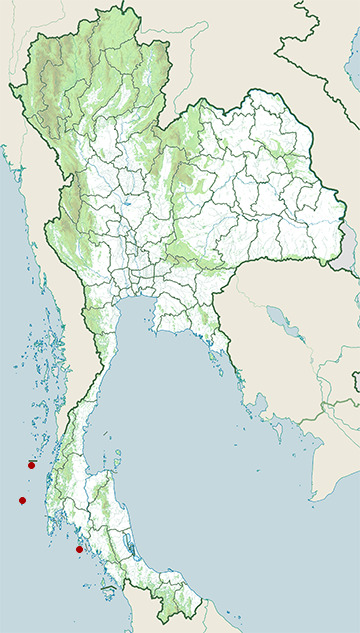
- Ko Lanta National Park
- Similan Islands
- Surin Islands
